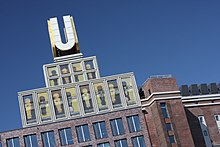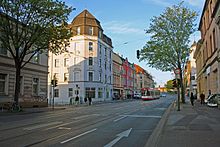Unionviertel
The Unionviertel is a district in the west of Dortmund city center. It is the statistical sub-district Union in the district of Dorstfelder Brücke , city district Innenstadt-West .
For a long time, the area around the Dortmunder U and along the Rheinische Strasse was characterized by structural change, vacancies and social upheavals. Vacancies are now filling up with new offers and the area is also enjoying increasing demand and a multicultural population as a residential area for artists, creative people and students.
For the Capital of Culture year RUHR.2010 - European Capital of Culture , the Dortmunder U , which is part of the Unionviertel, was converted into a museum and the surrounding area was upgraded. With the so-called "Flying Pictures", the Dortmunder U has become known far beyond the Ruhr area . In addition, the Robert Bosch and Robert Schuman vocational colleges were opened.
location
The Unionviertel is located in the city district of Innenstadt-West and belongs to the statistical district of Dorstfelder Brücke . It extends over an area of 1.55 km² along the Rheinische Strasse between the Westentor at the Dortmund Wallring in the east and the Emscher Bridge in the west. The southern border is formed by the S-Bahn line from Dortmund-Dorstfeld to Dortmund-Stadthaus , in the northern direction the quarter is bounded by industrial production facilities ( ThyssenKrupp , HSP ) on the site of the former Dortmund Union . Due to its location, the district acts as a link between the Kreuzviertel in the south and the northern part of the city .
population
At the end of 2013, 1,483 people lived in the district; the population in the district is relatively young. The proportion of minors (under 18 years of age) was around 17.6% at the end of 2013 (12.4% in the city center-west district), while the proportion of over 65-year-olds was 8.4% (in the city district 17% ). The proportion of foreigners was 43.6% (district 15.4%), the proportion of migrants was 61.6% (district 31.6%). In 2013, 30.6 percent of the population were employed subject to social security contributions (district 50 percent) and 22.5 percent were unemployed (district 11.9% and city of Dortmund approx. 12.5%).
A Catholic and a municipal kindergarten cover the care of small children; the Beuthstraße 21 location of the Tremoniaschule, a municipal special needs school , was closed in spring 2012. Other social institutions are the center for deaf culture and a production school as an educational institution for disadvantaged young people. Meeting points with advice are offered by the family center of the Catholic kindergarten, the Tamil association, the mosque association and the Polish mission. The House of Diversity is now housed at Beuthstrasse 21, where a large number of migrant organizations are located.
history
industrialization
The period of industrialization brought Dortmund a great economic boom in the middle of the 19th century. The strong population growth resulted in extensive residential developments along the arteries from the city center and near the industrial plants. The Wilhelminian style buildings were interspersed with a wide variety of businesses, often in the backyards of the buildings. It was mostly merchants and small business owners who built the houses. Due to the great demand and the overall poor living and environmental conditions around the industrial plants, the savings and construction association was founded in 1893, which promoted cooperative housing construction. By the end of the 19th century, several modern cooperative residential complexes and a. built in Adler, Lange and Paulinenstrasse. From 1900 onwards, various breweries increasingly settled along Rheinische Strasse in the district. At the west gate stood the Dortmunder Union Brewery with its tower ( Dortmunder U ) built in 1926 and optically “crushed” the Linden brewery next to it. To the west followed the Dortmunder Ritter Brewery , the Germania Brewery and the Dortmunder Actien Brewery on the Dorstfelder Bridge . The Rheinische Strasse was popularly known as the "Beer Street" and "Beer Mile".
Second World War
Due to its location between the large industrial plants, the quarter was badly damaged in World War II. A large part of the buildings along Rheinische Strasse and around the Dortmunder U were destroyed and some modern or not rebuilt. In the western section of the district, however, the building structure is strongly divergent and has a high proportion of old buildings from the Dorstfelder Bridge.
From the 1970s
With the decline of the defining industries in the mid-1970s, the quarter slowly declined; the vacancy rate at the end of 2009 was 9.4 percent, well above the average for the city of Dortmund (3.6%). Since the tram lines 403 and 404 were laid underground, the urban redevelopment associated with structural change in recent years has led to a revitalization of the quarter, which is becoming increasingly attractive again. Due to the low rents, the favorable transport connections and its urban structure with a high number of Art Nouveau buildings, the Unionviertel has developed into an attractive environment for artists, creative people, innovative founders and students.
today
The Unionviertel is part of the Rheinische Strasse urban redevelopment program . Since 2012, an image campaign has been trying to expand the name Unionviertel to the entire urban redevelopment area Rheinische Straße and the statistical district of Dorstfelder Brücke and to revive the quarter as a creative quarter .
Apartments and buildings
The residential development west of the Dorstfelder Brücke in the statistical sub-district Union includes apartments that are mostly privately owned. While in the eastern area block perimeter development with Wilhelminian style facades predominates, the building structure loosens towards the west, most of the buildings were built before 1949.
In the Union Gewerbehof on Huckarder Straße, a vital location for small and medium-sized companies has developed with the help of start-up financing from the initiative of unemployed people. All properties are rented, around 60 companies employ 190 people. The city of Dortmund wants to expand the location by converting apartments into commercial space. However, due to the high demand for student apartments in the district, this strategy will not materialize.
The St. Anna Church and the former Union administration building are located in the district. From 2018 the building is to be converted into a four-star hotel with 210 rooms on an area of around 15,500 square meters.
traffic
On the southern edge of the Unionviertel is the Dortmund West train station, where the S-Bahn line S 4 between Dortmund-Lütgendortmund and Unna stops.
The U 43 and U 44 tram lines run on Rheinische Straße with the stops Ottostraße, Ofenstraße, Heinrichstraße, Unionstraße and Westentor. In addition, the district is served by the bus routes 452 and 453 of the DSW21 .
swell
- Final report of the small-scale neighborhood analysis "Union Quarter", City of Dortmund (PDF; 4.1 MB)
- City of Dortmund: What has happened so far - milestones in the development of the Unionviertel
- City of Dortmund: Projects as part of the Rheinische Strasse urban redevelopment concept
Web links
- Unionviertel.de
- District marketing 'Unionviertel'
- RuhrNachrichten.de, photo series "Tour through the Unionviertel"
- videomap Unionviertel
Individual evidence
- ↑ A quarter becomes union - Rheinische Strasse urban redevelopment is completed. Retrieved March 9, 2020 .
- ↑ Dortmund Statistics: Statistics Atlas 2015. (PDF; 25.4 MB) In: dortmund.de: Department of Statistics. City of Dortmund, 2015, accessed March 7, 2020 .
- ↑ Dortmund Project: Conversion of the Hoesch administration. Retrieved November 16, 2016 .
Coordinates: 51 ° 30 ′ 42.7 " N , 7 ° 25 ′ 58.9" E







